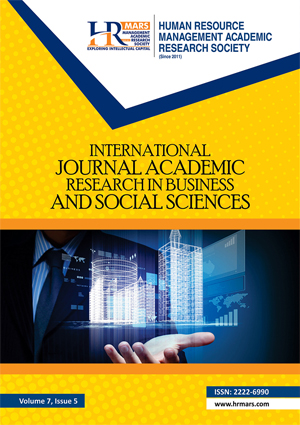
ISSN: 2222-6990
Open access
Global demand for ethical, safe, and high-quality food products from both Muslim and non-Muslim consumers is driving significant growth in the halal food industry. This growth is reflective of changing consumer preferences toward more responsible consumption, along with a rising awareness of halal principles that extend beyond religious obligations to encompass health and ethical considerations. This paper focuses on the halal food business in Thailand, particularly through the lens of Charoen Pokphand Foods (CPF), one of the country’s largest and most influential food producers. By analyzing CPF's operational frameworks, market strategies, and the challenges it faces in the halal segment, this study aims to provide comprehensive insights into the dynamics of the halal food industry in Thailand. The research findings indicate that while CPF has achieved notable progress in halal certification and has successfully penetrated various markets, there are significant gaps that hinder further growth. These gaps include limited consumer awareness about halal products and their benefits, as well as challenges related to regulatory compliance in certification processes. Additionally, the study identifies barriers to market entry for smaller producers and the competitive pressures from both local and international players. Based on these findings, the paper presents targeted recommendations aimed at enhancing consumer education, improving the transparency of halal certification, and fostering collaborative efforts among stakeholders in the halal food supply chain. By addressing these issues, CPF can better position itself in the market, leveraging its strengths to capitalize on the expanding halal food sector both domestically and internationally.
Ali, A., & Kadir, A. (2022). Consumer perceptions of halal food products: A study in Malaysia. Journal of Islamic Marketing, 13(4), 765-783. https://doi.org/10.1108/JIMA-12-2020-0434.
Alkashami, M., Abbas, S. I., Danish, F., Jasim, R., & Riyath, M. I. M. (2024). Unveiling the dynamiza in learning and education: Investigating the impact of efficacy, literacacy and support on student engagement. Community Practitioner, 21(7), 2411-2428.
Al-Qaradawi, Y. (2019). The Lawful and the Prohibited in Islam. American Trust Publications.
Aziz, A. A., Ahsan, N., & Khan, M. (2021). Challenges and opportunities in the halal food sector: A review. International Journal of Food Science & Technology, 56(5), 2531-2540. https://doi.org/10.1111/ijfs.14740
Braun, V., & Clarke, V. (2006). Using thematic analysis in psychology. Qualitative Research in Psychology, 3(2), 77-101. https://doi.org/10.1191/1478088706qp063oa
Camarena, M. D. (2020). Brand loyalty in the halal food market: The role of consumer trust. Journal of Business Research, 112, 200-207. https://doi.org/10.1016/j.jbusres.2019.10.046
Chalapati, R. (2020). The role of Charoen Pokphand Foods in Thailand’s halal industry. Asian Journal of Agriculture and Rural Development, 10(3), 208-215.
Chong, L. C. (2020). Non-Muslim consumers' awareness of halal food: Implications for marketing strategies. Journal of Consumer Marketing, 37(1), 55-67. https://doi.org/10.1108/JCM-11-2018-3534
Fatimah, U. (2022). Building trust in halal certification: A stakeholder approach. Journal of Islamic Marketing, 13(2), 312-328. https://doi.org/10.1108/JIMA-02-2021-0071
Hassan, S. H. (2021). Understanding consumer behavior in the halal food market: A study of non-Muslim consumers in Malaysia. British Food Journal, 123(4), 1232-1246. https://doi.org/10.1108/BFJ-08-2020-0654
Khalid, F., & Abdul, S. (2019). The impact of consumer behavior on halal food marketing strategies. International Journal of Marketing Studies, 11(3), 45-55. https://doi.org/10.5539/ijms.v11n3p45
Kvale, S. (2007). Doing Interviews. SAGE Publications.
Mustafa, H. (2023). Consumer behavior trends in halal food purchasing: A longitudinal study. Journal of Food Products Marketing, 29(1), 101-119. https://doi.org/10.1080/10454446.2022.2023450
Nguyen, T. P. (2023). Evaluating the effectiveness of halal certification: Insights from consumer engagement. Food Quality and Preference, 95, 104374. https://doi.org/10.1016/j.foodqual.2021.104374
Omar, A., & Kadir, A. (2016). Supply chain management in halal certification: A case study. Journal of Supply Chain Management, 52(1), 25-40. https://doi.org/10.1111/jscm.12145
Pahi, M. H., Shah, S. M. M., Ahmed, U., & Umrani, W. A. (2016). Investigating the issue of nurse job satisfaction: Role of esprit de corps, task significance, self-efficacy and resilience: A case study. International Journal of Academic Research in Business and Social Sciences, 6(4), 339-355.
Rahman, A. (2020). The economic potential of halal food markets in Southeast Asia. Journal of Economic Perspectives, 34(2), 137-156. https://doi.org/10.1257/jep.20190068
Riaz, M. (2022). Consumer trust in halal certification: The case of the halal food market. International Journal of Consumer Studies, 46(2), 207-219. https://doi.org/10.1111/1470-6431.12640
Riaz, M. N., & Chaudry, M. M. (2015). Halal Food Production. CRC Press.
Riaz, M. N., & Chaudry, M. M. (2015). Halal Food Production. CRC Press.
Shamsudin, M. N. (2024). Strategic positioning in the halal food industry: Challenges and opportunities. Asian Journal of Business Research, 14(1), 90-105.
Warde, A. (2021). The Halal Economy: A Global Perspective. Cambridge University Press.
Warde, A. (2021). The Halal Economy: A Global Perspective. Cambridge University Press.
Yin, R. K. (2018). Case Study Research and Applications: Design and Methods. SAGE Publications.
Cheumar, M., Yunita, P., Salleh, F., Ayuningtyas, R. D., & Fauzi, M. (2025). Halal Food Business and Industry: A Case Study from CPF (Thailand) Experiences. International Journal of Academic Research in Business and Social Sciences, 15(2), 798-807.
Copyright: © 2025 The Author(s)
Published by HRMARS (www.hrmars.com)
This article is published under the Creative Commons Attribution (CC BY 4.0) license. Anyone may reproduce, distribute, translate and create derivative works of this article (for both commercial and non-commercial purposes), subject to full attribution to the original publication and authors. The full terms of this license may be seen at: http://creativecommons.org/licences/by/4.0/legalcode